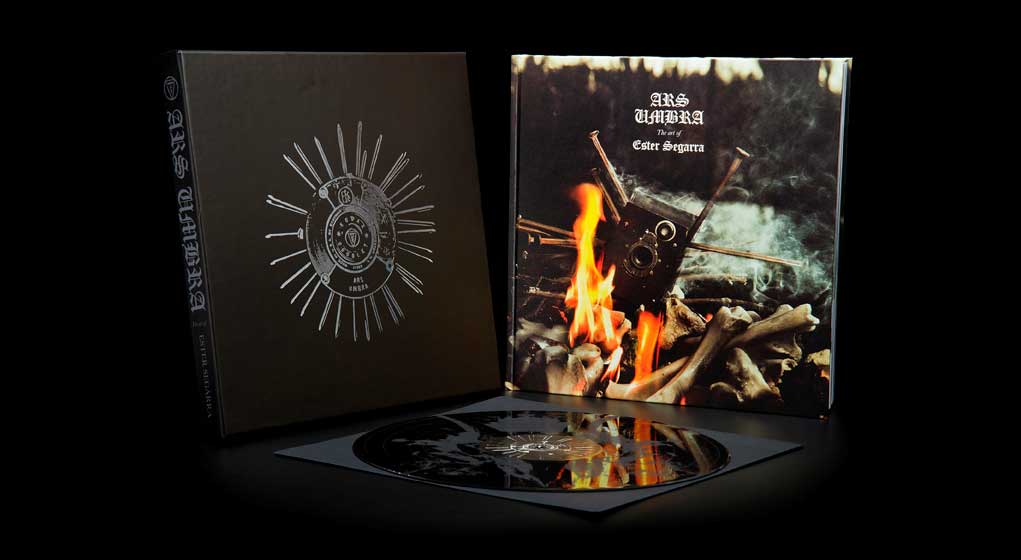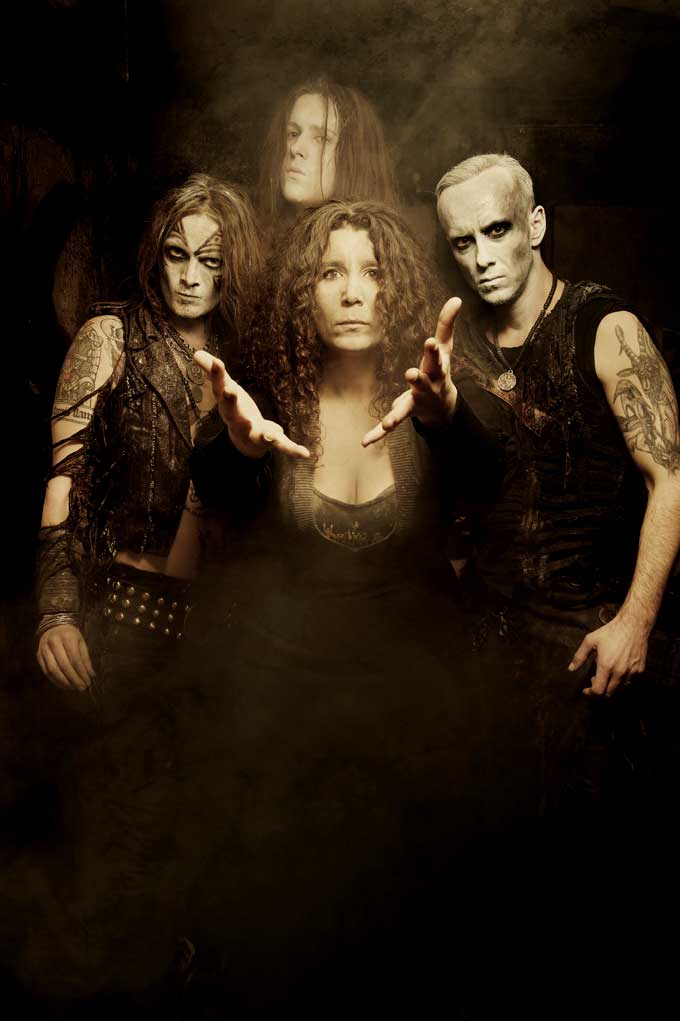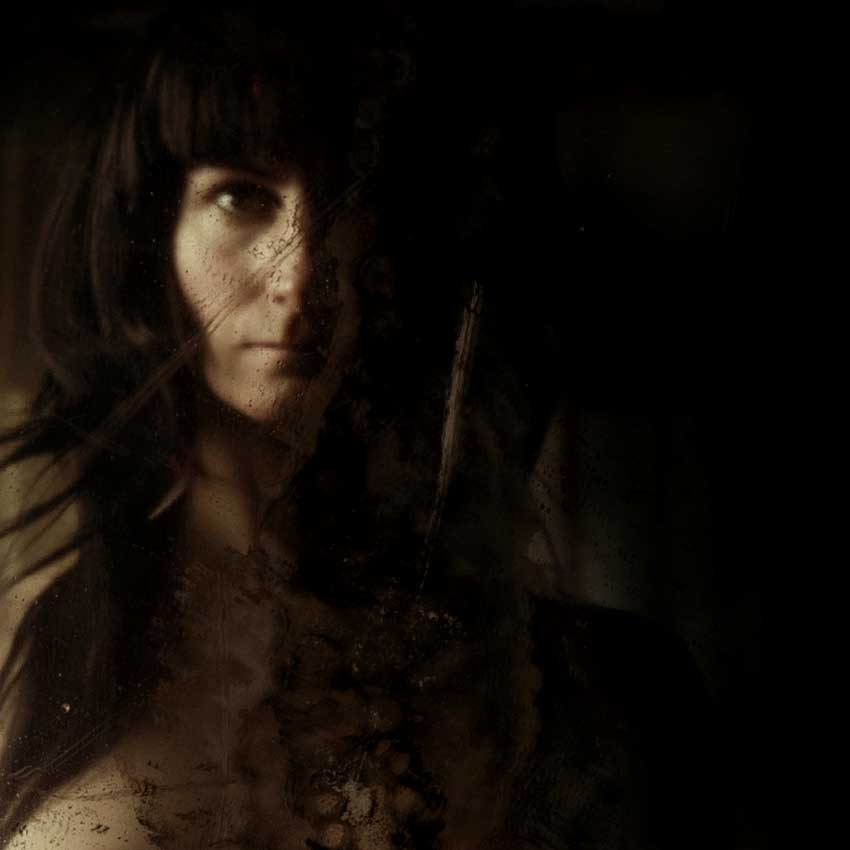Ester Segarra
2018-07-25
by Niklas Göransson
Spanish photographer Ester Segarra has spent the past fifteen years documenting underground metal. In celebration of a career built on iron will and merciless self-discipline, she’s now compiled the commemorative anthology Ars Umbra.
– The end is the beginning, the snake devouring its own tail. I decided to create this book as a retrospective glance and fifteen-year memorial of what’s been my life in metal music photography. The project wasn’t simply about gathering some images together but rather looking back and reflecting over my accomplishments. A way to mark the end of one chapter and the beginning of a new, essentially. For this I needed time, as well as solitude, and my life in London was incapable of providing that – so I left for the forests of Sweden. It also allowed for retrospection and understanding of the huge body of work I’ve created over the years.
After an arduous process of sifting through over half a million photos, the carefully chosen selection manifested as Ars Umbra – a 220-page photo book including over 150 pictures, courtesy of Ester Segarra. Anyone who’s been frequenting European underground events during the past decade is likely to have spotted Ester skulking about with her camera.
– ’Ars umbra’ means art of the shadow, it’s a vinyl-sized book designed to fit your record collection. The box-set edition also comes with the soundtrack on etched vinyl; a percussion-based score which was composed and recorded by Uno Bruniusson (DEATH ALLEY, MAGGOT HEART) with the set purpose of inducing rhythm and pulse capable of altering the visual experience; music and photography coming together in reverse roles. The book’s images were all inspired by music and its soundtrack draws you in through mankind’s most primal instrument: drums. This ties in with the original application of musical power – ritualistic beats intended to forcibly bring your mind elsewhere without first asking permission.
The idea for an audible addendum to the book came to Ester after she attended a Macumba ritual in Brazil. Macumba is an umbrella term for a number of religions derived from Afro-Brazilian spiritism – it’s currently practiced in Brazil, Argentina, Uruguay, and Paraguay. These customs were initially brought to the continent by African slaves during the 16th century and then proceeded to seep into ordinary society once the practice of slavery was abolished. Ritual is an integral aspect of Macumba and rites are carried out by means of trance-oriented tribal percussion, ceremonial dancing, as well as sacrifice of both blood and spirit.
– I was invited as a guest and allowed to document it. The ritual takes place over two days, the first of which is only available for those who’ve been chosen; offerings were made and contact established. The second day is open to anyone who wishes to attend or take part under guidance of more experienced practitioners. Ritual drums are constant throughout the ceremony, seizing hold of participants beyond their control – the power of music in its purest and most base form. Some strong, dark powers emanated… not for the faint of heart. I was unprepared and barely survived but, in the end, it turned out to be one of the most life-affirming experiences I’ve ever had.
How did you first get into photography?
– My earliest memory of visual expressions having an impact on me is from early childhood – I was browsing through a book and came across some random photo of a sunset. Sitting there in my dark room, far from the exotic lands of that setting sun, everything froze and for a moment I was taken away. Through nothing but an image, a connection was made to this foreign and unknown place; the visceral power of photography transported me somewhere else… without my permission.
Despite the profound impact this experience had on her, she wasn’t able to act on the impulse until much later in life.
– I was born and raised in a very traditional Catholic family and back then photography, just like all art, was not a serious career option. When I was a teenager, alongside traditional subjects such as history, maths, and so forth there was an opportunity to take on additional courses such as computer science, cooking, or photography… my parents were hoping and very much insisting on me studying computers but I wanted to do photography – I saw it as my very last chance of giving it a shot. But, as I was so accurately reminded, I didn’t even have a camera. I didn’t care, nor did I need anyone’s approval, so after borrowing a camera from my friend I enrolled anyway. The first picture we took was with a shoebox on photographic paper… it was absolute magick!
In 1997, with about a hundred British pounds in her pocket, Ester moved from her hometown of Barcelona to the United Kingdom.
– Arriving in London with little money, barely any English, and without a single local contact gave me no choice but to work my ass off and do whatever I could to survive. It became very clear that I was entirely on my own and if I couldn’t put food on the table, no one else would. I learned about self-reliance the hard way and also discovered how stubborn, driven, and hard-working I can be. I remember times when I barely had ten euro to survive the week, walking to work in order to save money, finding all the tricks to get by living in one of the most expensive cities in the world – all the while learning the ways and language of a new country. I worked as a waitress during both my studies and early days of freelance photography, seven days a week if need be, reasoning that sleep could wait until I’m dead… just kept going, desperately trying to stay afloat.
During these early years of essentially surviving on nothing, it must have spelled disaster without end if camera equipment were to be stolen or broken.
– Luckily nothing major happened. The back of one of my film cameras broke and I remember using duct-tape for a while to keep it closed. Also, as part of my quest of doing everything possible to help out my photography I took on work in a camera shop, which had many advantages – from borrowing equipment to great staff discounts. I was fortunate to meet several allies who’ve been incredibly helpful still to this day. Interestingly, when my flat was broken into they found the camera but left it behind on the bed. Most likely things would’ve been very different now if they’d taken it.

Ester’s original plan was to reside in London for only a few months over summer, working like a demon in order to bring home as much money as possible to finance further photography studies. Alas, shortly before she was scheduled to return, her place of residence was burglarised and all accumulated savings stolen, paving the way for an empty-handed homecoming. This was not an option so, seeing as how she still had the waitress job and – admittedly somewhat miraculously – her camera, Ester decided to stay and let the chips fall where they may.
– It felt like the worst form of catastrophe – beyond devastating. I hated life so much; that feeling you have when everything sucks big-fucking-time. It was only years later I realised that if this hadn’t happened, my life would’ve taken an entirely different path and, looking back at everything I’ve accomplished since that moment, my perception has changed from disaster to boon… as they rightly say: curses are blessings in disguise. And they can be disguised as a curse for many fucking years, believe me.
But, as previously implied, this little debacle ultimately ended up paying off as it allowed her to find a way into the industry. While generally not prone to charlatanry in recent times, Ester was forced to employ covert tactics in order to get a foot in the door.
– I was still studying photography and building my portfolio when I wanted to go see NEBULA, but the gig was sold out so I approached the venue and told them I worked for some Spanish music magazine and needed a photo-pass. They said yes! That was over fifteen years ago, when there was hardly anyone with professional camera equipment at gigs. Back then, taking photos would cost you money. Using slide-film, like I was, would set you back twenty euro for one roll of thirty-six frames with no option to delete once you’ve taken the photo… unlike the free shots you get with smartphones nowadays. I managed to not fuck up the pictures so I had the idea of approaching a few magazines to see if they were interested. One of them was Terrorizer, who liked them enough to give me my first freelance assignment: STATIC-X at the Astoria. I still remember how nervous I was, walking into the venue, finding my way to the pit and the horror of being told I only had three songs to shoot them! I must have done a decent enough job though – Terrorizer loved the photos and that was the beginning of a collaboration which would last for many years; doing live shots, feature photos and, eventually, many covers.
At which point did it feel as if you’d finally succeeded?
– Not much has changed really – I work just as hard still to this day so I honestly couldn’t tell you what success feels like, haha! I believe that what I’ve succeeded in doing is dedicating time and energy on what fuels my fire, without compromising in any way. I’ve left jobs that wouldn’t allow me to prioritise photography and I’ve been sacked for choosing to go shoot a gig for nothing instead of doing my shift and earning money. None of this was done with any assurances but rather the sensation you have of jumping off a cliff, only to realise how there’s always another ledge beyond that edge and all you need to do is dig in and never give up. It’s the fear that stops you from living.
Ester says she realised early in life that following only her heart – as opposed to reason geared towards finances, stability or security – was the only viable way forward.
– I refer to the heart as this voice coming not out of logic or rationality but from a place of love. It could be instinct, intuition, or gut feeling… but if it comes from love then I believe it’s the heart. ‘It’s impossible’ said pride, ‘it’s risky’ said experience, ‘it’s pointless’ said reason… ‘give it a try’ whispered the heart. I will always follow whatever voice is telling me to give it a shot and if that’s a deranged way to live, then I must be totally bonkers!

What’s the worst hassle you’ve endured for a photoshoot?
– There’s always hassle! Being at the mercy of managements, middlemen, airport security, airlines, public transport, bureaucracy… one of the most logistically challenging shoots was for the first Decibel Tour cover: BEHEMOTH, WATAIN, THE DEVIL’S BLOOD and IN SOLITUDE. Four extremely busy musicians and one photographer, four countries, three different labels, more than two-hundred emails over months of working out logistics and budgets… many times the whole thing was so close to falling apart! But fuck it, we got there in the end.
While Ester’s musical portfolio encompasses all manner of metal, most of it relates to black metal in one way or another.
– Finding home changes everything and that’s the feeling I had when first coming across black metal. I connected with a part of myself which was always there but had never before found an expression; some would call it the shadow. Once the flame was alight, all I wanted was to explore more of it – letting myself be consumed by the fire. 2010 brought a likewise formative moment when I felt the smell of death at Wolf’s Lair, the old WATAIN bunker in Stockholm. The energy and their uncompromising, fearless, lawless attitude that I was hit by the first time I worked with them. The commitment they have to everything they do, their defying attitude of walking through town bare-chested, covered in blood and carrying scythes and torches through the snow, pulling all their resources for the photo-shoot just like they do for shows and music. It was very life-affirming because that’s how I like to do things too.
When you glance out over your surroundings, do you think your photographic inclination affects the way you interpret the world?
– It surely does… sometimes I process reality in monochrome, other times in colour, and when relating to ideas I usually see things in scenes or frames. I never fully switch off the ‘taking pics’ mode – if not with a camera I’ll be doing it mentally. Many times at concerts I need to close my eyes to stop myself from constantly thinking about taking photos and be able to fully lose myself.
Approaching an article such as this, by the time I start writing it I’ll generally have formulated a basic framework for what I want to do: which type of pace and momentum, where to begin and what to end on, and so forth. I’m assuming Ester employs a similar methodology when working with her clients.
– Preparing for a shoot, I go to the band’s core; their art and actions. I’ll listen to the music, preferably whatever material they’re currently working on, and take into consideration what they’ve done before, their careers, achievements, etcetera. Shooting musicians who’re just starting out is not the same thing as someone with twenty years of experience. If possible, I’ll have direct contact with the band to discuss ideas and thoughts. When listening to music, images are constantly flooding my mind. I can also get into that frame of mind during the shoot, where I sever my connection with reality and what’s happening around me other than what I’m photographing; I lose my sense of self entirely, moving around and just channelling and capturing what’s unfolding in front of the camera. I’m completely in the zone – being too close to fire or a knife in the hands of a murderer, too cold, too high, too dark, too windy, too rainy, too hot, too dangerous – none of that matters. By the end it’s like waking up from a dream… or a nightmare, haha!
Are you still getting better at photography or have you hit your peak?
– Still to this day I often feel as if I don’t know what I’m doing. For me, the process is always the same: you start with nothing until you have something. The challenge lies in the process through which you create what you capture and the honesty therein. I like to challenge myself technically, so as soon as I feel I’ve mastered one technique or a way of doing things, I’ll begin working with another. Just like failure is part of success, success can be a failure – attempting something different or even greater. For me it’s an ongoing process of learning, challenging, trying, discovering within and without.




